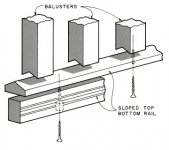I've been replacing rotting wooden porch railings around my house for years. For the replacement rails, I'm using a design that features a sloped-top bottom rail to shed water. I buy the railing parts from a firm in Texas that will cut v-notches in the baluster bottoms they deliver. However, they don't offer this service for stair railings, which require compound mitre cuts. My insurance company is giving me until April to install railings along the concrete steps to my porch. A local contractor will do the job ... for $2598. That's for labor only. For that price, I figure I may as well invest in the right tools to do it myself.
So ... what's the right tool? For years, I've been getting by with hand tools, a track saw (Festool TS55), and a MFT 1080 (the old version of this table). This is one of the first cases where I've come to the conclusion my tools (or my skills?) aren't quite up to the job. I can do it crudely like so:
1. set the saw depth to 1/2 the width of the baluster (1.25 inches divided by 2)
2. set the saw bevel angle to 30 degrees (to account for the bottom rail slope
3. set the miter fence to 35 degrees (to account for the stair slope)
4. cut half the notch; flip the work piece over 180 degrees; reset the miter to -35 degrees; cut the other half of the notch.
Doing this on the MFT is very awkward, inefficient, and imprecise. Probably the biggest problem is getting the bevel angle and the depth to match exactly on both cuts, then repeat this exactly for 26 balusters.
I don't have a table saw and don't want to allocate space for one. I think a router table with a tenoning jig might work well, but might be dangerous, and wouldn't be too versatile for the work I usually do.
How about the Kapex 60 or Kapex 120? I definitely could use a SCMS for lots of jobs around my place. Would they offer the precision, accuracy, repeatability, ease of use, etc., for a job like this? A Kapex 60 (cordless) with the mobility cart and extension wings would run $2300 + tax. I could set it up right under the porch, where there is no electrical outlet.
So ... what's the right tool? For years, I've been getting by with hand tools, a track saw (Festool TS55), and a MFT 1080 (the old version of this table). This is one of the first cases where I've come to the conclusion my tools (or my skills?) aren't quite up to the job. I can do it crudely like so:
1. set the saw depth to 1/2 the width of the baluster (1.25 inches divided by 2)
2. set the saw bevel angle to 30 degrees (to account for the bottom rail slope
3. set the miter fence to 35 degrees (to account for the stair slope)
4. cut half the notch; flip the work piece over 180 degrees; reset the miter to -35 degrees; cut the other half of the notch.
Doing this on the MFT is very awkward, inefficient, and imprecise. Probably the biggest problem is getting the bevel angle and the depth to match exactly on both cuts, then repeat this exactly for 26 balusters.
I don't have a table saw and don't want to allocate space for one. I think a router table with a tenoning jig might work well, but might be dangerous, and wouldn't be too versatile for the work I usually do.
How about the Kapex 60 or Kapex 120? I definitely could use a SCMS for lots of jobs around my place. Would they offer the precision, accuracy, repeatability, ease of use, etc., for a job like this? A Kapex 60 (cordless) with the mobility cart and extension wings would run $2300 + tax. I could set it up right under the porch, where there is no electrical outlet.

